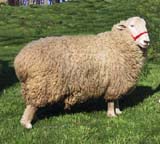
The Coopworth is a modern New Zealand breed of sheep. It was developed by researchers at Lincoln College in the Canterbury region of the South Island between about 1956 and 1968, the result of cross-breeding of New Zealand Romney ewes and Border Leicester rams. It has become the second-most numerous sheep breed in New Zealand, and has been exported to Australia, some European countries, and the United States.

The Drysdale is a New Zealand breed of sheep. It was developed from 1931 by Francis Dry, and derives from sheep of the New Zealand Romney breed in which a mutation caused the coat to be particularly hairy, and thus suitable for carpet-making. It is a specialised carpet wool breed, but also a useful meat breed.
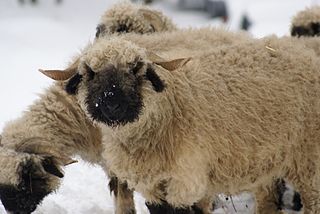
The Valais Blacknose, German: Walliser Schwarznasenschaf, is a breed of domestic sheep originating in the Valais region of Switzerland. It is a dual-purpose breed, raised both for meat and for wool.
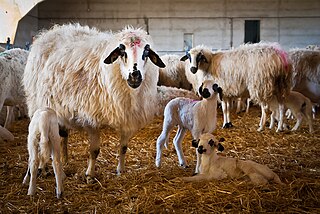
The Churra is an Iberian type, breed or group of breeds of sheep. The word churra simply means 'coarse-woolled'. The Churra originates in the Duero Valley in the autonomous community of Castile and León in north-western Spain. In the province of Zamora the milk is used to make Zamorano cheese.
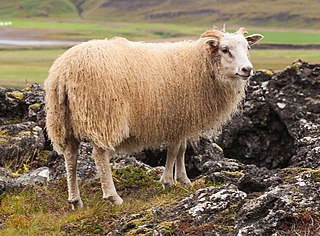
The Icelandic is the Icelandic breed of domestic sheep. It belongs to the Northern European Short-tailed group of sheep, and is larger than most breeds in that group.

The Suffolk is a British breed of domestic sheep. It originated in the late eighteenth century in the area of Bury St. Edmunds in Suffolk, as a result of cross-breeding when Norfolk Horn ewes were put to improved Southdown rams. It is a polled, black-faced breed, and is raised primarily for its meat. It has been exported to many countries, and is among the most numerous breeds of sheep worldwide.

The Lonk is a British breed of domestic sheep. It belongs to the group of black-faced hill breeds of northern England, and is found in the hills of the central and southern Pennines of Lancashire and Yorkshire. It is documented from the mid-eighteenth century; a flock book was started in 1905.

The Oxford Down is a British breed of domestic sheep. It was developed in the 1830s by cross-breeding of Hampshire Down and Southdown ewes with Cotswold rams. It is reared primarily for meat.
The Easycare or Easy Care is a modern British breed of easy-care sheep. It was developed in Wales in the second half of the twentieth century by cross-breeding between Welsh Mountain and Wiltshire Horn stock, with the aim of combining the meat-producing qualities and natural moulting characteristic of the latter with the hardiness of the former. It is reared for meat production.

The Dorset Horn is an endangered British breed of domestic sheep. It is documented from the seventeenth century, and is highly prolific, sometimes producing two lambing seasons per year. Among British sheep, it is the only breed capable of breeding throughout the winter.
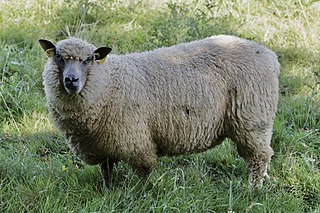
The Bleu du Maine is a French breed of domestic sheep. It originated in the historic region of Maine, and is distributed mainly in the départements of Maine-et-Loire, the Mayenne and the Sarthe in the Pays de la Loire in western France.

The Pelibüey or Spanish: Cubano Rojo is a Cuban breed of domestic sheep. It is found principally in Cuba, where it is the most numerous breed of sheep, but is also reared elsewhere in the Caribbean and in some coastal parts of Mexico. It is a hair sheep – its coat is of hair, not wool; this is a common adaptation to tropical environments. It is likely that it derives at least in part from African breeds of sheep such as the West African Dwarf, and probable that it is related to other American breeds of African origin such as the Barbados Black Belly, the Roja Africana of Venezuela and the Oveja Africana of Colombia.
The Devon Closewool is a British breed of domestic sheep. It is distributed almost exclusively on Exmoor in North Devon, in south-west England. It is raised primarily for meat.
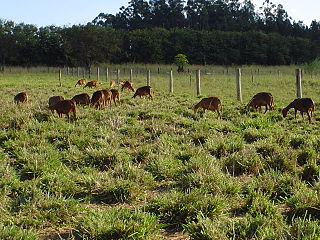
Morada Nova is a Brazilian breed of domestic sheep. It originates in the state of Ceará, in Nordeste, the north-eastern region of Brazil, on the Atlantic coast.
The West African Dwarf or Djallonké is an African breed or group of breeds of domestic sheep. It is the dominant breed of West and Central Africa. This breed is primarily raised for meat. The Cameroon or Cameroon Dwarf is a breed within this group.

The Cameroon or Cameroon Dwarf is a Cameroonian breed of domestic sheep. It belongs to the West African Dwarf group of breeds. Some have been exported to Europe.
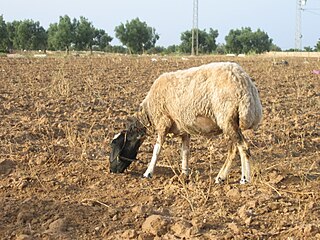
The Tunisian Barbarin is a Tunisian breed of fat-tailed sheep. It is distributed throughout Tunisia, and on both sides of the Tunisian border with Algeria, on the Algerian side particularly in the area of Oued Souf. Related to the Awassi

The Cambridge is a modern British breed of domestic sheep. It was bred at the University of Cambridge by John Owen and Alun Davies between about 1964 and 1979, with the aim of increasing prolificacy. It is among the most prolific of all sheep breeds, but is critically endangered.

The Blue Texel, Dutch: Blauwe Texelaar, is a Dutch breed or strain of meat sheep. It is a colour variety of the Texel, which originates on the island of Texel in the Wadden Sea. A flock-book for blue sheep within the Texel breed was started in 1983, and a breed society was formed in that year.

















